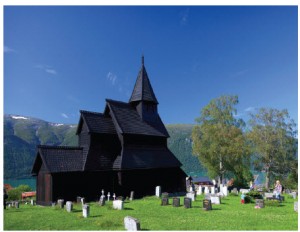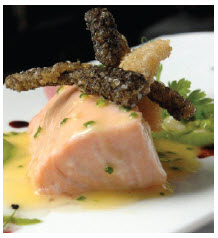
Norway is a land of contrasts — a modern nation with strong ties to its history and traditions. We can offer wild, impressive and untouched nature, but also refined cultural expressions and innovative architecture. Regardless of how long you visit, you will have the opportunity to see these for yourself. Every part of our geographically long country has something unique to offer, and rural and urban settings both offer a combination of the modern and historic, the rugged and the sophisticated. For centuries, Norway has attracted visitors from around the world, people who would like to experience this natural beauty up close.
Even as a girl from the capital Oslo, I grew up in close proximity to nature. From our parents we learned to camp outdoors, ski, swim and fish. We picked berries in the autumn and marinated fish for Christmas. Being outside was, and is, a natural part of daily life, no matter the season. When people visit Norway, they soon understand why this is the case. Our nature is highly accessible. Whether it is hiking in the mountains or sailing in the fjords, it is all outside your door.

The national tourist routes
Over the past 20 years, the Norwegian Public Roads Administration has been working on an ambitious project to build a network of National Tourist Routes in Norway. Eighteen stretches of road run through some of Norway’s most outstanding nature and attract visitors from far and wide.
Norway’s beautiful and varied natural surroundings are the main attraction, and the pillars of the National Tourist routes are mountains, fjords, waterfalls and the picturesque coastline. But the project also highlights modern design and architecture along the way. Top designers and architects were invited to create innovative lookouts, rest stops, museums and visitor centres, thereby adding a unique element to the travel experience. Well-groomed rest stops along the roads offer the opportunity for up-close experiences in nature. Creative and functional architecture constitutes an exciting attraction in itself and leads users out into nature, down to the seashore, up to the mountain heights or out towards breezy panoramas.

The use of modern architecture in harmony or in contrast with the landscape and surroundings is the distinctive feature of these attractions and leaves traces of our time. The architects and designers, both Norwegian and international, responsible for the construction have followed strict esthetic standards in a way that harmonizes with the surroundings and reinforces travellers’ appreciation of the great outdoors and unspoiled countryside. All 18 tourist routes offer a wonderful view of the surrounding landscape and would be worth a visit, but I have chosen to share a couple of my favourites with you here. And let me add: The very best is to cruise these roads in an open car, no matter the weather.
Aurlandsfjellet Mountain Road

This route on the west coast of Norway runs from fjord to fjord across high mountains where snow remains most of the summer. Stegastein on the Aurland road (the snow road) has always been an attractive viewing point. As part of the project, a new viewing platform was designed by Todd Saunders, a Canadian architect working in Bergen, and Norwegian architect Tommie Wilhelmsen. The viewing platform built in 2006 at Stegastein is light, dynamic and lofty and a perfect complement to its surroundings. It is constructed of linden wood and lifts you 30 metres out into the air and 650 metres above the fjord. This offers a magnificent view of the stunning fjord landscape.
The Atlantic Highway
Between the western cities of Kritiansund and Molde, we find another great example of how humans and nature interact successfully. The Atlantic Highway stretches across the archipelago with a series of cleverly designed bridges that let you island hop on wheels. The seven bridges that arch between the islets and skerries on the edge of the ocean not only present a magnificent view, they are also an outstanding feat of engineering. This highway is known as the world’s most beautiful car journey. Britain’s newspaper The Guardian called it the best road trip in the world.

The Northern Lights and the midnight sun
Northern Norway is a spectacular destination, especially in the summer and winter. Here, you can experience natural beauty in extreme forms. In the winter, the sun disappears after only a few short hours, and the polar night sets in. The polar night is widely referred to as the season of colour due to the array of beautiful blue tones as the light fades.
The winter marks the season of another spectacular phenomenon — the Northern Lights or Aurora Borealis, which translates to “the red of morning in the north.” The Sami, the indigenous people of the north, call it “the light that can be heard.” (Scientists think they’ve unlocked the secret of the mysterious clapping sound the Northern Lights produce: The same type of electrically charged particles from the sun that cause the Northern Lights also create the sound when they collide with gases in the Earth’s atmosphere.) The Northern Lights play a special role in shaping the Norwegian imagination and identity.
In summer, you can see or feel the sun’s presence at all hours of the day. The promise of never-ending light gives you extra energy to enjoy new experiences. You might find that you want to play golf or go fishing in the middle of the night, or feel the bracing wind in your face as you kayak from island to island.
Northern Norway is the closest mainland to the North Pole. The areas bordering Sweden, Finland and Russia are still a natural and unspoiled paradise, and the breathtaking combination of sea and mountains you find in Lofoten, Vesterålen and the Lyngsalpene peaks are unparallelled in Europe.
The people of Northern Norway enjoy the freedom of living their lives to the rhythm of nature. The Sami have lived at one with nature and developed their culture since settling in the Arctic areas of Norway more than 11,000 years ago. Tromsø, known as the Arctic capital, is bustling with activity during the summer. National and international artists perform at summer festivals, adding musical colour to the long well-illuminated nights.
The fjords: a living landscape
You do not travel to the attractions in Fjord, Norway. You travel through them. Whether you travel by car, bike, on a coastal steamer cruise or by foot, the journey itself is the experience. The ever-changing landscapes with majestic mountains and glittering white glaciers, offer new views around every corner. In the picturesque towns dotting the coastline, you can taste the local delicacies. It could be freshly caught cod or salmon, or freshly picked apples or cherries, depending on your location and the time of year. Along the road, you will also come across farm stores that carry local products, foods and crafts and where you will meet friendly locals who are more than happy to share information about what to see or do in the area. They might tell you about a little-known hiking trail, show you a good fishing spot, or offer you room and board in a redecorated boathouse overlooking the water and the mountains across the other side.
The fjords are not as much a place in Norway as they are a place in the world. Geirangerfjord and Nærøyfjord received UNESCO World Heritage status as a cultural landscape. National Geographic has called the fjords the world’s most well-preserved World Heritage site. But why? Because Fjord Norway is not a scenic backdrop, but a community — a living landscape where humans and nature live in mutual dependence. And still, roads meander their way through all of this.
In the footsteps of the Vikings
For many visitors, Norway is the ultimate Viking destination. Vikings seem to be emerging stronger than ever in today’s film and television and Norway offers people a chance to experience that culture. In Norway, you are never far from history — it surrounds us in our buildings, our infrastructure and our cultural traditions. Remnants of the Viking era are found across the land. It can be a grave mound, a stone cross or a wooden stave church that dates back almost 1,000 years. Throughout the country, several museums detail how our ancestors lived. It is thrilling to think that the Viking routes to North America connected us more than 1,000 years back, and that trade routes between the Norsemen and the population of Baffin Island may have existed even before that.
The Vikingship Museum in Oslo is a given for anyone with an interest in the Vikings. Many festivals and open-air historical plays will also give you a taste of Viking life. Traces of the Vikings’ first seat of power may be found at Avaldsnes, in Haugesund, where this period is well documented. Here, you can visit one of Norway’s replica Viking settlements complete with longhouses and Viking ships.
City life
For those who like a more urban experience, Norway has some vibrant and exciting cities, each with its own distinct identity.
My hometown of Oslo, our nation’s capital, is our largest city. It also dates back to Viking times, and represents a unique blend of history and culture. Oslo is home to many of our major cultural institutions, such as national museums, the National Gallery, theatres and concert halls. This is where you come to see Edvard Munch’s painting, The Scream, take in the Henrik Ibsen theatre festival or perhaps have a picnic on the roof of our iconic waterfront opera house. Numerous music and art festivals will keep you entertained and the diverse neighbourhoods will offer a taste of a more multicultural Norway.
In Stavanger, the oil capital of Norway, you will find white wooden houses and coastal traditions combined with the hustle and bustle of a dynamic international oil industry. This “global” city is full of life. This is also Norway’s food capital and where you find the Norwegian Culinary Institute and where New Nordic Cuisine is emerging and taking shape.
The Hanseatic city of Bergen is perhaps our most distinct city. Its Hanseatic heritage (part of the Hanseatic League trading alliance of northern European cities roughly from the 1300s to the 1700s) is clearly visible in the architecture of the historic waterfront (another UNESCO World Heritage Site), and the world-famous open-air fish market offers locals and visitors alike amazing treasures from the sea. Bergen is saturated with culture, with something to please everyone — from music to contemporary art. Not only is Bergen the hometown of famous composer Edvard Grieg, its philharmonic orchestra is the oldest orchestra in the world. And to add to that, the concertmaster is an Ottawa native, master violinist David Stewart.
Norway’s cities are not very big in size or population, but they are huge on personality. One of my personal favourites is Ålesund on the northwestern coast. It was voted most beautiful town in Norway in 2007 and again in 2009 by the British newspaper The Times. The story behind Ålesund is quite dramatic. On a stormy winter night in 1904, a devastating fire raged through the streets of Ålesund. After 16 hours, 850 houses were burned to the ground, leaving 10,000 people homeless.
After a remarkable effort, the town was rebuilt just three years later in 1907. The architects in charge were young Norwegians, influenced by national romantic ideals as well as the popular style of the time: “Jugendstil” or Art Nouveau. When a whole town is built over the course of three years, all in the same style, it creates a unique appearance. The buildings are decorated with towers, turrets and imaginative and colourful ornaments. When you walk around Ålesund and take the time to look around you, you will notice all the small details that make these houses so beautiful. Today, Ålesund is renowned nationally and internationally for its architecture and is a member of Rèseau Art Nouveau Network, a European network of Art Nouveau cities that includes, among others, Glasgow, Barcelona and Vienna.
Culinary delights
No vacation would be complete without good food. Traditional Norwegian food is wholesome and rustic, with fresh ingredients and natural flavours at the centre. Salmon, cod and mutton, fresh, cured or smoked, all play an important part in our culinary identity. However, as part of the “new Nordic food” movement, Norwegian restaurateurs and chefs are constantly using their creative minds to take Norwegian food traditions in new directions. This is reflected in our success at the “World Culinary Championship” Bocuse d’Or, where Norway has won gold five times, most recently in January 2015, when chef Ørjan Johannessen brought home the win. The freshest and best of ingredients can be found locally and natural flavours are still at the centre of Norwegian food. Yet these young innovative chefs are combining ingredients or presenting the food in completely new ways, while making sure quality and taste remain absolutely top notch. And do not forget the Aquavit — the water of life — the flavoured potent liquor that can help against the most extreme cold. For a truly gourmet experience, enjoy a taste of Norway.
Mona Brother is the ambassador of Norway.




